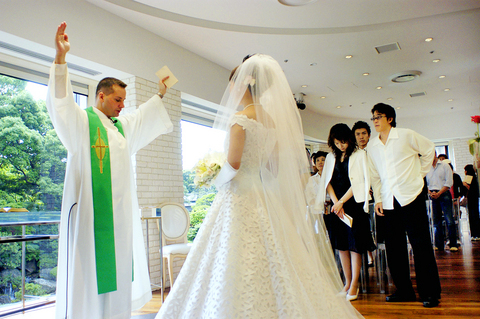As a soprano sings "Ave Maria," a Japanese couple march down the center aisle of a hotel chapel, past white trumpet lilies, to the altar where a US "pastor" stands, gold cross gleaming on white robes.
"Before God and these witnesses, I pronounce you husband and wife," intones Damon Mackey, a California native who took a two-day course to perform weddings on weekends, supplementing his income as an English teacher and part-time actor.
In Japan, where a love affair with Western "white weddings" is leading to a collapse in Shinto ceremonies, a new figure is taking over the altar: the gaijin, or foreign, "pastor."

PHOTO: NY TIMES
Only 1.4 percent of Japan's 127 million people are Christians, but Christian-style ceremonies now account for three-quarters of Japanese weddings. To meet market demand, bridal companies in recent years have largely dispensed with the niceties of providing a pastor with a seminary education, keeping the requirements simple: a man from an English-speaking country who will show up on time, remember his lines, not mix up names and perform the ceremony in 20 minutes.
From a small beginning a few years ago, the Western wedding "priest" has suddenly become an established part of modern Japan's cultural tableau. The lure of easy money has prompted hundreds of foreign men to respond to newspaper advertisements here, like the one that read: "North Americans, Europeans wanted to conduct wedding ceremonies."
"Now all the hotels have chapels with someone dressed up as a priest," said William Grimm, a Maryknoll priest who edits the Catholic Weekly of Japan.
faker is better
In fact, the less overtly religious the pastor, the better. Hotel managers generally discourage proselytizing by authentic Christian pastors.
"The companies like the nonreligious guy who just follows the script," said Mike Clark, a Japanese language student who performed weddings before moving home to Canada last fall.
The boom in what some Japanese magazines call "foreign fake pastors" speaks volumes about modern Japan's attachment to appearances and its smorgasbord approach to religion. Japanese often choose Shintoism for childhood age ceremonies, Christianity for weddings and Buddhism for funerals.
"Of course, words are important, but in a ceremony it is more about the whole image," Masahiko Sakamoto, 25, said after watching Kenyon Nelson, a retired businessman from Missouri, perform a wedding at a hotel bridal fair. "And a foreigner fits better into a Western wedding than a Japanese person would."
Maki Oyama, his fiancee, said firmly that she wanted a white dress, a foreign pastor and a hotel chapel wedding. She added, "In soap operas you have more examples of white weddings than of Shinto ones."
rising popularity
The passion for Western-style weddings was first fueled in the 1980s by the televised weddings of Prince Charles and Lady Diana and of the Japanese pop star Momoe Yamaguchi. Since 1996, according to the Ministry of Economy, Trade and Industry, the number of Christian weddings has nearly doubled while the number of Shinto weddings has plunged by two-thirds.
Western weddings revolve around love and elevate the bride to a princess, Japanese say. In a tradition-bound Shinto wedding, where the bride is encased in a wig and a kimono, the ceremony often seems to be more about the merger of two families.
Only civil unions are legally valid here and with Japan's economy treading water, about 70 percent of all couples go on to have an optional religious ceremony. Now, hotels are tearing out money-losing Shinto shrines and replacing them with the ersatz Christian chapels staffed with a foreign "priest."
"I am supposed to finish in 18 minutes," Victor Spiegel, a 37-year-old Florida native, said after walking a pair of models through a touching, if briskly paced, wedding ceremony for a bridal fair. Overhead, a movie camera had run on a ceiling track, filming a three-woman chorus singing "Ave Maria," the couple marching past red roses suspended in crystal columns, and white curtains opening to a hotel garden where a green neon cross glowed in the afternoon sun.
Spiegel, an English teacher who performs more than 100 weddings a year, said that sometimes "the hotel will do 15 in a day."
At a bridal fair here, couples insisted that the Christian "pastor" had to be a foreigner. Youichi Hirahara, a 27-year-old civil servant, said: "It would seem very unreal and fake if there was a Japanese person conducting the ceremony. Very shady actually."
falling wages
Among foreigners, competition has depressed the pay for a wedding ceremony to US$120, from US$200 five years ago. In a society that revolves around business cards, the card of one part-time "pastor" reads: "Max von Schuler Kobayashi: Performer, Actor, MC, Wedding Minister."
While the prime motivator for the Western wedding ministers is cash, many take an extra pride in their work.
"My goal was to make at least one person cry at each ceremony," said Clark, the Canadian student. He said performing weddings was a great part-time job "but kind of kooky, kind of surreal."
"There was the whole factory aspect of it, the 20-minute turnarounds," he said. "All icing, no cake. Then, there I was, an atheist, reading and reciting these Japanese Christian scripts that I barely understood."
Reg Hackshaw, 42, a New Zealander who performs weddings, said that he was "raised as a Catholic, but got fed up with the hypocrisy." Asked if spending his Sundays dressed as a priest and marrying non-Christians at a hotel "chapel" conflicted with his agnosticism, Hackshaw answered: "OK, I am dressing up in a robe, but it's not a religious ceremony. It's a performance."

DISASTER: The Bangladesh Meteorological Department recorded a magnitude 5.7 and tremors reached as far as Kolkata, India, more than 300km away from the epicenter A powerful earthquake struck Bangladesh yesterday outside the crowded capital, Dhaka, killing at least five people and injuring about a hundred, the government said. The magnitude 5.5 quake struck at 10:38am near Narsingdi, Bangladesh, about 33km from Dhaka, the US Geological Survey (USGS) said. The earthquake sparked fear and chaos with many in the Muslim-majority nation of 170 million people at home on their day off. AFP reporters in Dhaka said they saw people weeping in the streets while others appeared shocked. Bangladesh Interim Leader Muhammad Yunus expressed his “deep shock and sorrow over the news of casualties in various districts.” At least five people,

LEFT AND RIGHT: Battling anti-incumbent, anticommunist sentiment, Jeanette Jara had a precarious lead over far-right Jose Antonio Kast as they look to the Dec. 14 run Leftist candidate Jeannette Jara and far-right leader Jose Antonio Kast are to go head-to-head in Chile’s presidential runoff after topping Sunday’s first round of voting in an election dominated by fears of violent crime. With 99 percent of the results counted, Jara, a 51-year-old communist running on behalf of an eight-party coalition, won 26.85 percent, compared with 23.93 percent for Kast, the Servel electoral service said. The election was dominated by deep concern over a surge in murders, kidnappings and extortion widely blamed on foreign crime gangs. Kast, 59, has vowed to build walls, fences and trenches along Chile’s border with Bolivia to

DEATH SENTENCE: The ousted leader said she was willing to attend a fresh trial outside Bangladesh where the ruling would not be a ‘foregone conclusion’ Bangladesh’s fugitive former prime minister Sheikh Hasina yesterday called the guilty verdict and death sentence in her crimes against humanity trial “biased and politically motivated.” Hasina, 78, defied court orders that she return from India to attend her trial about whether she ordered a deadly crackdown against the student-led uprising that ousted her. She was found guilty and sentenced to death earlier yesterday. “The verdicts announced against me have been made by a rigged tribunal established and presided over by an unelected government with no democratic mandate,” Hasina said in a statement issued from hiding in India. “They are biased and politically motivated,” she

It is one of the world’s most famous unsolved codes whose answer could sell for a fortune — but two US friends say they have already found the secret hidden by Kryptos. The S-shaped copper sculpture has baffled cryptography enthusiasts since its 1990 installation on the grounds of the CIA headquarters in Virginia, with three of its four messages deciphered so far. Yet K4, the final passage, has kept codebreakers scratching their heads. Sculptor Jim Sanborn, 80, has been so overwhelmed by guesses that he started charging US$50 for each response. Sanborn in August announced he would auction the 97-character solution to K4